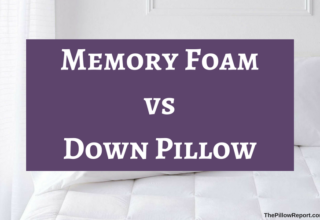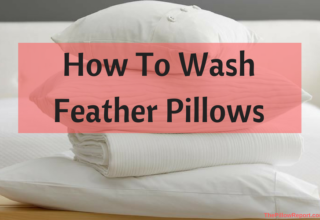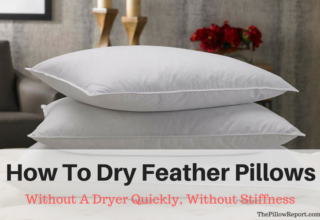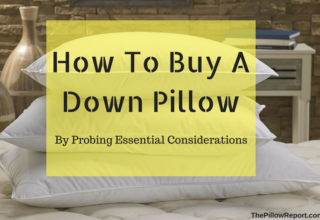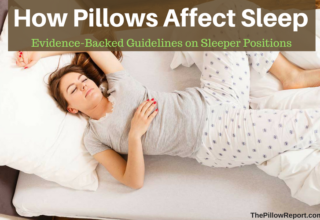Everyone says goodnight in their unique sleeping posture: from side snorers to the paunch snoozers, to other angles. Given that some of these positions do not promote neutral spinal alignment, you must tool up with a tailor-made pillow to nip health conditions in the bud.
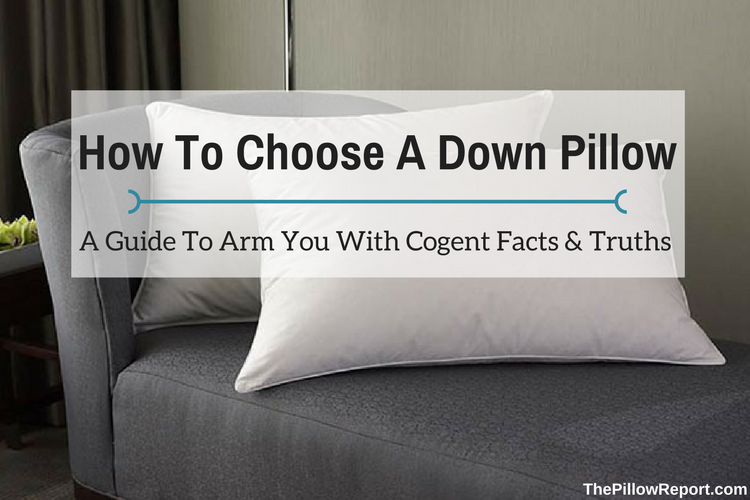
Regardless of sleeping angles, your pillow must render optimum neck and spinal support. Consider the level of comfort, filling, breathability, size, firmness and durable construction to zero in a sleep-inducing head-support without biomechanical stress on the spine, neck or head.
Things To Consider | How To Choose A Down Pillow
1. Pillow Sizes & Dimensions
Size and aesthetics make a spitting image of each other. For single-sized or double-sized beds, select a standard version. If you have a King-sized or California super-king, get an equivalent pillow or throw in 4 to 6 standard pads.
- In the US, pillows usually come in three dimensions, viz. Standard (20” x30”), queen (20” x30”), and king (20” x36”).
- Down and feather-filled or down-alternative pillows offer the three sizes
- Other types of memory foam offer nonstandard sizes and shapes like wedges and oval travel pillows
- Square or continental pillows (18” x 59”) bedeck your bed linen ensemble
2. What Position Do You Take To Sleep?
Front Sleepers should choose a soft pillow with a lower height for a position and angle that aligns your spine correctly. You will only require a slight amount of padding and backing.
Back sleepers conk off on the back and need a medium support level that slightly raises your head for neutral spine alignment. A medium-firm pillow will cradle your head during sleep with ample support and comfort.
If you sleep on your side, a firmer high-height pillow will cozily fill the gap between your head and shoulder with natural spine alignment and support.
For those who keep readjusting positions, a medium-firm and slightly thick pillow renders overall comfort with head and back support.
3. Natural vs. Synthetic Fillings
Feather and down cut a wide swath in the market. Feathers pack more weight and size than down. They boost bulk and support to your bed pillow. Down contributes a buttery-soft and super-lightweight loft for a luxurious snuggle.
Other natural fillings include silk, wool, and cotton. They possess a firmer finish than down due to the thicker fibers in yarn or minimal loft from cotton or silk. The natural materials hypoallergenic and air permeable properties make easy pickings for allergy suffers.
Synthetic materials include polyester, memory foam and super microfiber. Top-class versions provide customized neck, head and shoulders’ support while they capture air between the fibers to create a luxuriously cozy ambiance to curl up and sleep at a stretch. They offer anti-allergenic, dust mite-repellent and easily washable beddings.
4. Soft vs. Firm
- Soft Pillows with less filling and density have a flat-lining that inches you closer to your mattress diminishing the slant of your neck. It allows natural alignment of the chest, shoulders, and neck without arching the lower back for stomach sleepers or those who adjust positions often.
- Medium Firmness for back sleepers packs more filling and density giving your head and neck proper support with the sustenance of the alignment and curvature of the upper spine and back.
- Firm pillows have the highest filling volume, and density for side sleepers increase pillow depth for expanded shoulder room and an excellent horizontal alignment along the neck and spine. They create an extra layer of support to your head and neck.
5. Does Thread Count Matter?
Pillowcases have a specific thread-count indicated by a “T” or “TC” followed by a number. Thread count suggests the number of threads per square inch of fabric. A higher thread count yields a softer texture, better quality craft, and opulent feel.
You can acquire a standard-sized 20” x26” bed pillow with a minimum of 300TC at budget-conscious prices and superior comfort. If you want hotel-quality luxury, a pillow weaved with 500-to-800 thread-count provide a super-plush option.
Exquisitely designed 1000 thread-count pillows create superior upscale hotel comfort due to the ultra-slick hand, sumptuous weight, and polished appeal. The highest thread-count boasts top brass craftsmanship and exceptional materials.
6. Fluff Factor
Side sleepers require a fluffier pillow to feed into the gap carved up for your shoulders to settle into the mattress while your head aligns with the spine. Back sleepers thirst for a thinner pillow with a slightly added loft in their bottom third for backing. Stomach sleepers dovetail with the most lightweight pillows.
- A fluffier pillow remains as fresh as a daisy for efficient airflow while a lifeless, deflated and flattened one does not trap air making it a source of discomfort
- To determine fluffiness, fold the pillow halfway and observe if it restores original volume. If it flexes out of shape, you may have to acquire a new pillow.
7. Comfort and Breathability
Your pillow’s comfort level contributes to health-giving, dead-to-the-world slumber. A comfy pillow strikes a balance between support and comfort shoring up your head, neck, and shoulders optimally. If you flip excessively or wake up with shoulder pain, neck or migraines, it’s a marker to seek a new level of firmness.
8. Manufacturer Care Directions
Cleanable pillows allow machine-and-hand-washing while others call for dry-clean methods. Some pillows only require fluffing to restore their loft or shape. Allergen sufferers tend to wash pillows frequently; machine-washable options endure cleaning ravages.
- A detachable, washable cover-Adding a machine-washable and dryable cover will keep clean-averse pillows in shipshape for allergen sufferers or kid’s accidents.
- Washing down and feather pillows resuscitates the filling’s fluffiness as opposed to synthetic materials
- Solid or shredded foam pillows come out in tatters after machine-washing
- Non-washable pillows require laundry tumble-dry or dry-clean
Final Verdict
With this earful of information on how to choose a down pillow and your thinking cap, you can strike a balance between comfort and support. If you experience neck, upper spinal and shoulder pain, it’s a marker of an improper pillow.
The pillow world’s extensive collections and tip top brands offer a masterwork cut for every individual sleeper. Top-end materials like goose down act as an efficient heat insulator and coolant, they create a cozy environment.

